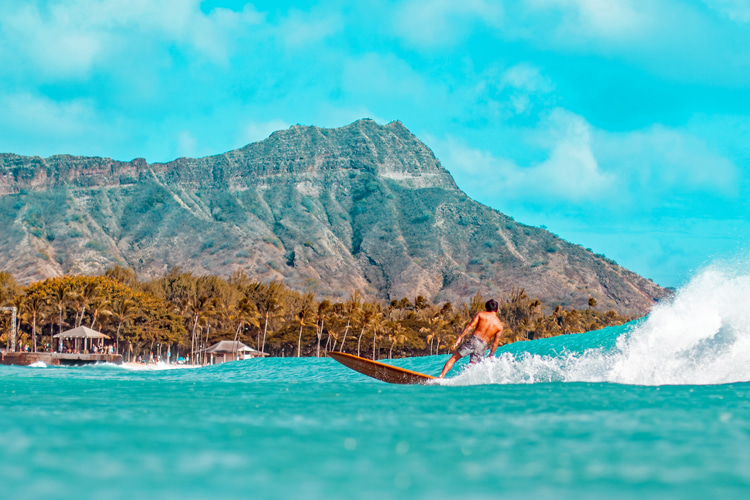At the beginning of the previous chapter, I mentioned that we had started to go to Poplars in the summer because of the crowds at Canoes.
The name Poplars is a pidgin corruption of "Populars" because native surfers liked it so much.
This area, together with Castles, Elks Club, Public Baths, and Cunhas, makes up the rest of the surfs in Waikiki, which were not described in Chapter IV.
When the surf is up, the best rides are available in these locations.
Poplars is to the left of the Reef Hotel, almost over to the Royal Hawaiian, and is about three-quarters of a mile out to sea.
There are three swift breaks on a narrow front with waves which peak in places not always easy to predict.
The waves are often one and a half times to twice as large as those at Canoes on the same day.
I found them rather frightening the first time out, but they are usually sufficiently narrow that you can avoid the breakers if you're fast at paddling.
The unpleasant coral heads which imperiled the first Poplars break have now been removed.
The paddle out from the Moana to Poplars takes 10 to 15 minutes, and this deters a lot of surfers, as does Herman, a 16-foot hammerhead shark who haunts the place.
Fortunately, Herman has a clean slate and has bitten no one to date - I have never seen him, but several people have.
Bob Hansen actually touched a dorsal fin of a sleeping hammerhead one day way out past Queen's, thinking it was a palm frond.
He is reputed to be the only man in history to have surfed his board into the beach at full speed without the aid of surf!
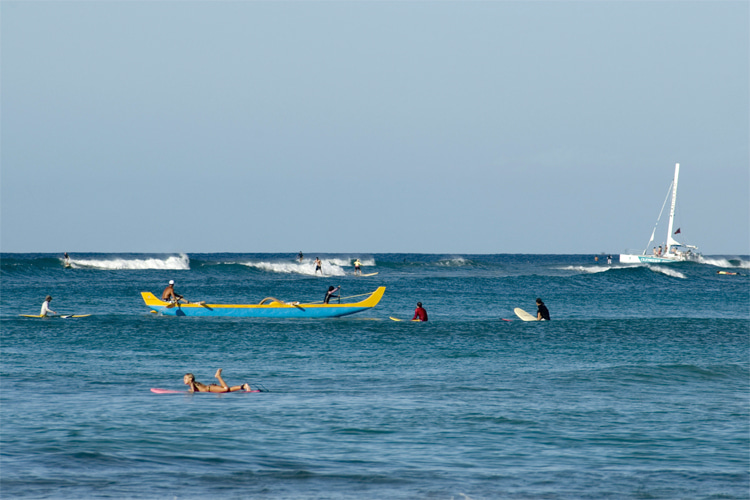
Poplars, Ala Moana, First Break, Public Baths, Elks Club, Cunhas and Castles
Poplars is a good step up from Canoes, as you have to be much more clever in catching the waves and getting the most out of them.
They are also bigger and swifter, and therefore rougher on mistakes.
In spite of the distance from dry land, the swim, if you are wiped out, is usually quite short, rarely over three hundred yards.
Except on really big days, the surf stops about half a mile from the beach.
The best Poplars break in front of the Reef Hotel is magnificent like a big beautiful Queen's. It's a thin wave like San Onofre in California.
The other surf types in the Poplars area are localized and similar, if smaller, and less well-shaped.
Down the beach past Hawaiian Village is another surf which is a post-war bonus produced by accident, called Ala Moana.
It is a man-made surf which was caused by the dredging of the coral to make Honolulu Yacht Harbor.
This is a fast, rather tricky, left slide surf up to about 10 feet which, if you are wiped out, may need a swim of two hundred yards over a jagged coral reef.
The waves at Ala Moana are well formed, and even small waves can give you a good ride.
Directly behind Canoes comes First Break, which is spasmodic, depending on a good storm from a southern swell.
When it runs, usually in summer, the waves break out beyond the buoy and may reach 15 feet in height.
In 1961, First Break ran for only three or four days and reached about 12 feet maximum, but at times there were waves across the bay.
Surfers, good and bad, had a riotous time in a whirlwind of arms and legs and flying boards.
Needless to say, this is not the stuff for beginners, but at the same time, it should be pointed out that First Break, like nearly all the waves at Waikiki, is a thin wave with only a small part of the breaking power of the monsters at Sunset Beach or Waimea Bay.
Toward Diamond Head, Public Baths and Elks Club are summer surfs which, although they can be surfed at all heights, are, at their best, magnificent long fast rides way out to sea behind First Break and only exceeded by Cunhas and Castles in their height, which is up to 15 feet.
Public Baths is the unfortunate possessor of a reef like the Maginot Line, which apparently discourages some surfers.
The waves beyond Elks Club are sometimes called Big Elks, and the waves before Castles, Baby Castles.
Cunhas, when it is running, is the hardest break in Waikiki, according to Tom Zahn, who has come down a breaking wave with such force that the soles of his feet hitting the water slammed his knees up against his chin and almost knocked him out.
On another auspicious occasion, as the wave dumped him unceremoniously in the trough, he was convoluted and entwined again.
Castles is the big surf at Waikiki, which may reach 30 feet.
This surf is rare these days, although there were two waves in 1961 which came unexpectedly, and so nobody was out to surf them.
Almost every Hawaiian summer has a couple of Castles waves that are seldom surfed, but surfers at least have the reassurance that they are still there.
Castles, like the other waves caused by southern swells at Waikiki, always come in the summer months; the storms which produce this surf are reported to originate in the New Zealand area.
This great surf, which was so good between the wars, was poor in the 1950s due, no doubt, to the lack of these needed storms in the South Pacific.
Castles may break up to two miles out to sea, humping up rapidly on the edge of the reef where the continental drop starts the sea's floor in its journey to the depths of the Pacific Ocean.
The best Castles wave is extremely rare, called a bluebird, which, when it comes, breaks right across from Diamond Head and continues in a solid line as far west as Honolulu Harbor.
Bluebirds were last seen in 1951.
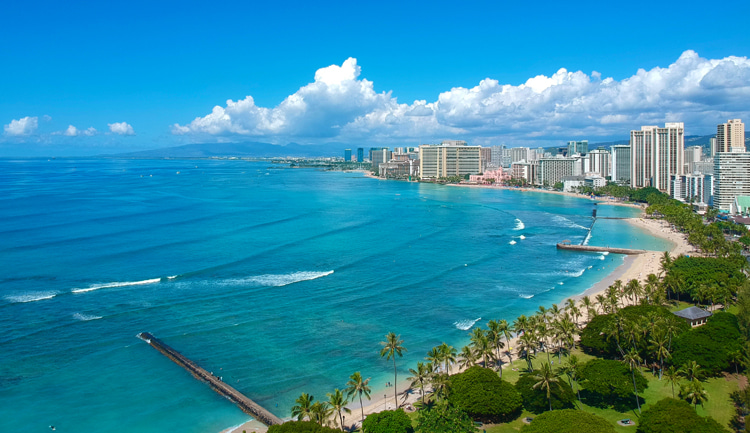
Experience Matters
When the big surf is running at Waikiki, the jungle drums spread the word all over the Islands, and surfers, young and old, fat and thin, rich and poor, appear as if by magic to try their favorite surfing spots.
Often all surfs are running at the same time, and there are lines of surf across the bay, a sight which infects surfer and spectator alike with drumming temples and a roaring fever of excitement.
There is only one place to get out under these conditions, and that is during a long lull in the space between Queen's and Canoes.
Then the competition starts as to who will dare to paddle out the furthest to ride the biggest wave and thus, as the Hawaiian chiefs of old, appear the bravest.
A few years ago, Bobby Krewson, a well-known island surfer, was paddling out further and further in an effort to be king of the Castles.
After struggling over crest after crest and missing some elephantine breaks, he was convinced he had left all his competition behind.
By this time, he was almost a mile out as he turned his board and prepared to show them.
Just at that moment, he looked around and saw George Downing coming, Neptune-like out of the sea behind him, nonchalantly riding the curl of a 15-foot wave.
It is theoretically possible to pick up a wave at Castles and ride one's board through all the other surfs to the beach in front of the Royal Hawaiian.
In their heyday, Duke Kahanamoku and his friends would pick up a wave in Steamer Lane and, with their seemingly unlimited surfing virtuosity, would frolic through Castles, Cunhas, Queen's, and Canoes, ultimately landing on the beach a distance of well over two miles.
Not many people today would care to risk a swim through huge breaking waves of that length and duration, even for the longest and fastest ride in the Waikiki area.
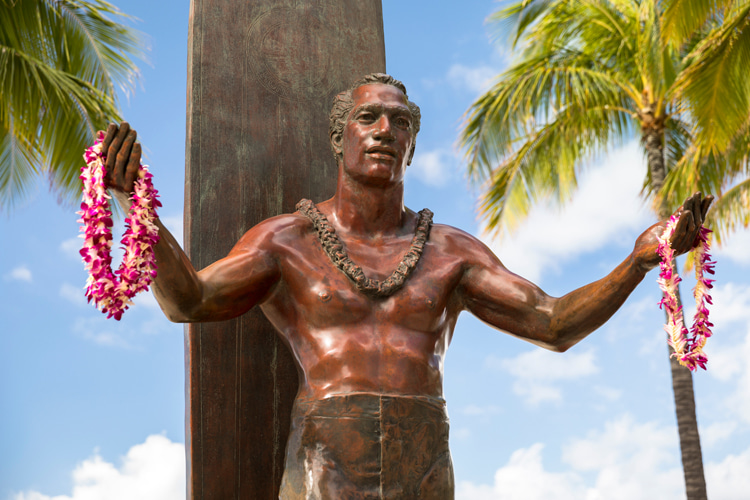
Oahu Big Wave Surfing
There is surf, at some time of the year, around the entire coastline of Oahu, and many good beaches for both board and body surfing are rarely used.
Most people have their favorite haunts where they know all the risks and have been exposed to almost every possible condition of surf.
They know how much energy they will need if they have to swim for it, where the coral is bad, and where the rips and currents run.
When you know a beach this well, you acquire a strange confidence even under the most unpleasant circumstances.
New beaches need cultivating like new friends, and first impressions can be very deceiving.
The so-called big wave beaches, Makaha, Waimea Bay, Pupukea, and Sunset Beach, are treated separately in the section on the "The Big Surf," although Pupukea is really a medium-sized wave up to 15 feet.
It is a thick wave and not to be trifled with.
Makaha can be surfed on relatively small days, although there are cross-currents which may panic weak swimmers.
None of these beaches should be surfed for the first time alone, and beginning and intermediate surfers are advised to take along an experienced friend whenever they try a new beach.
Yokahama Bay on the coastal road about two miles west of Makaha is a good surfing beach which is comparatively safe when there are no local storms running.
Haleiwa Army Beach, which is about half a mile west of the town, is sometimes good in the winter, with six to ten-foot waves, often when Sunset and Pupukea are unsurfable; the left side favors goofy-foots.
Haleiwa is another area which can be tried by relatively inexperienced surfers who can surf the waves about a hundred yards from shore after they have broken.
When windward Oahu is getting good surf, these run as often as every half minute and are an excellent experience for turning, cut-outs, etc., which can be practiced ad nauseam without the nuisance and lost time of waiting for waves or the annoyance of thousands of jostling surfers on rented boards, which is inevitably found in the learners' area on weekends at Waikiki.
These are great for cheap vacations and uncrowded surfing conditions. I am indebted to George Downing for much of this information.
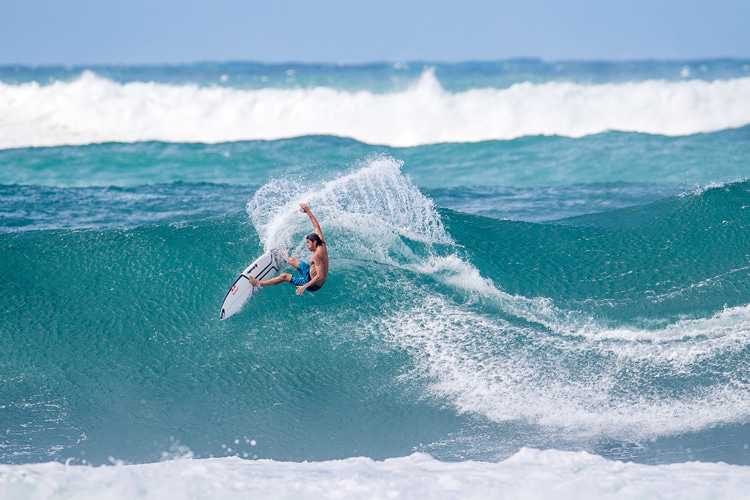
Kauai, Maui, Molokai, and the Island of Hawaii
On the island of Kauai, Nawiliwili Harbor, near the capital city of Lihue, has summer surf up to 8 feet.
Hanalei Bay, on the north side of the island, gets a very steady surf in winter up to 15 feet, and like northern surfs, it is consistent from October to January.
This is the beach where the movie "South Pacific" was made and is now home to the renowned Hanalei Plantation Hotel.
The island of Maui, which is the site of the great extinct volcano Haleakala, has Honolua Bay on the northwestern tip of the island which gets consistent winter surf with breaks up to 12 feet.
Kahului Harbor near the capital city, Wailuku, gets two breaks, one outside the harbor and one inside. The outside break is up to 20 feet in height, and the surf generally is biggest in winter.
However, this harbor gets the trade wind swell and so has some surf all the year-round.
There are many other surfing beaches in Maui which are at present being explored.
The island of Molokai - There is good winter surf near Wahilauhue on the west side of the island.
The rest of Molokai, much of which gets consistent surf of some kind, is either too shallow or is almost inaccessible by road, with sleepy mountainous terrain and treacherous waters.
The island of Hawaii was the scene of much surfing in the days of old Hawaii but nowadays is restricted mainly to body surfing on the Kona coast.
In most surfing areas in the world, the surf is at its best in the early morning or the evening, and certainly, conditions at Waikiki appeared extremely favorable at the outlandish hour at which Larry and George dragged me off in the mornings.
One thing I did learn from all this was that before you take off for the beach that early in the morning, you should have some milk or other liquid to drink or something light to eat before you surf.
Avoid violent exercise on an empty stomach. I described the delightful journey to the beach at the beginning of the previous chapter.
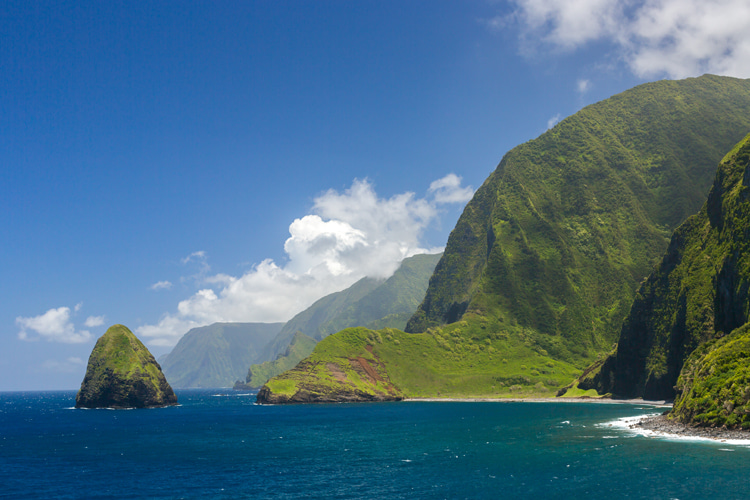
Eating and Relaxing in Honolulu
The termination of our surfing had consequences which were at least equally pleasant.
After we had finished and put our boards away (for the first month, I was still so weak I usually needed help from Larry or a beach boy to carry the 30-pound board in! ), we would retire to the Waikiki Pharmacy for an excellent breakfast of fresh orange juice, cornbread, and coffee.
Located opposite the once spacious grounds of the Royal Hawaiian Hotel (they cannot take away our memories ), the Waikiki Pharmacy is a light open restaurant with only a small drug store attached.
Although the food is excellent, the chief charm of the place lies in its happy, gay, friendly, warm-hearted staff who are always joking and laughing and glad to see you.
It has the nicest atmosphere of any coffee house that I have ever been in.
I later worked it out with Geoff Paterson, my Hawaiian office manager, that if we could have lunch at Woody's or the Gourmet, (depending on the distance to payday - his payday that is!) and spend the time from 6 to 8 p.m. beneath the Kiawe tree at the Halekulani (with the Hawaiian Quartet and the hula dancers ), we would have just the right amount of time left in the day for surfing.
The Gourmet, we thought, has food as fine as any you could get in Hawaii, and Woody's has wonderful sandwiches and delicious fresh fruit.
But the Halekulani (House of the Sun) has everything.
Perhaps the best recommendation for the Halekulani comes from the presence there of people from the other islands who stay at the hotel when they come to Honolulu.
They prefer it because it is filled with the heart-warming quintessence of everything Hawaiian - the old Hawaii, which we all love so well, but which is leaving us so fast.
The Halekulani is the last real link with the old Hawaii on Waikiki Beach, and not only is it the world's most breathtakingly romantic setting for a drink or a meal, but it also provides a ringside seat for the whole west side of the bay when the surf is up.
Here's to the Halekulani! May it forever resist the bulldozer!
To continue to see that you get your money's worth in this book and as a guide to any developers and hotel builders that can read, I would like to point out that the Halekulani is also a brilliant example of what I call site unity.
In spite of the fact that, including the cabins, there are only three acres all told, the buildings, paths, and gardens are so masterfully handled, and the spaces large and small are so cleverly interwoven that the site seems unending.
In contrast, the nearby Royal Hawaiian, which has 16 acres, and Hawaiian Village, which has 96 acres, have sites which are so cut up and confused that they seem very small.
A great effort should be made to keep the Halekulani on Waikiki Beach - and in its present state.
Words by Desmond Muirhead | Golf Course Designer and Author of the Book "Surfing in Hawaii" (1962)
Chapter IX of "Surfing in Hawaii" was published under the authorization of Rosemary J. Muirhead, one of the three daughters of Desmond Muirhead
